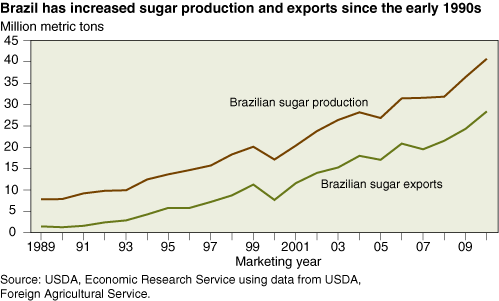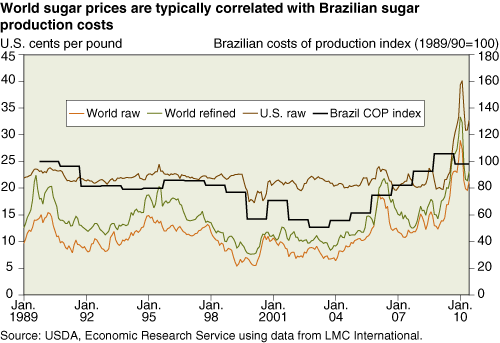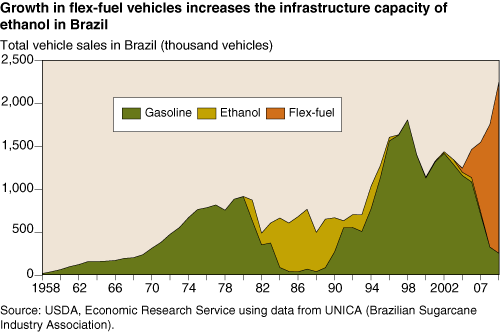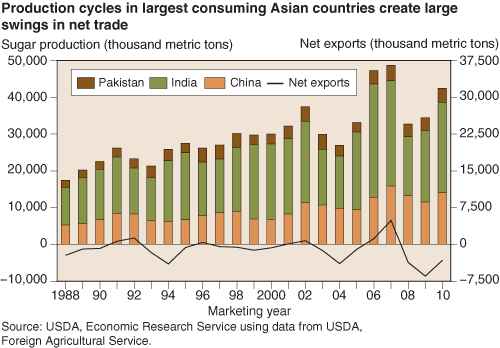World Sugar Price Volatility Intensified by Market and Policy Factors
- by Michael J. McConnell, Erik Dohlman and Stephen Haley
- 9/1/2010
Highlights
- Rising pressure on sugar prices was intensified by supply disruptions in 2009, driving prices to double the long-term average.
- Higher production costs and growing ethanol use in Brazil set the stage for higher prices, but policy-induced production swings among Asian countries are the main source of price volatility in world markets.
- Although dramatic fluctuations in world prices have affected U.S. sugar prices, domestic sugar policy continues to drive U.S. sugar price movements
World sugar prices soared to a 29-year high of nearly 30 cents a pound in early 2010 before falling back to half that level by early summer. Still, they remain 50 percent higher than average over the past 20 years. Was this price spike a temporary oscillation caused by a supply shock or does it reflect a more permanent fundamental shift in global market dynamics?
Evaluation of economic and policy factors driving production and trade in key global sugar markets supports both perspectives: underlying dynamics related to Brazil’s exchange rates and ethanol’s role in energy markets are putting upward pressure on global prices. However, the volatility of price movements in the past year was mostly the result of supply shortfalls tied to changing economic incentives, weather disruptions, and policy factors in other countries. The U.S. remains largely insulated from global sugar price movements, but external fluctuations are felt in the United States, particularly when prices are high.
Changing Production, Use, and Policies Affected Global Sugar Market in 2009-10
Global sugar production fell nearly 20 million tons (12 percent) in the 2008/09 marketing year (October 2008-September 2009) in response to lower acreage, weather disruptions, and policy developments. While prices of other commodities increased in 2007 and 2008, sugar prices remained relatively stable. As a result, sugar acreage declined in many parts of the world as producers switched crops in response to increased returns for competing commodities. Weather-related reductions in yields further hindered production in 2008/09. At the same time, consumption of sugar continues to increase, helping to boost average world raw sugar prices in 2009 to almost double the long-term average of 11 cents per pound.
Policies fostering the industrial use of sugarcane also increased demand. Brazil, the world’s largest sugar producer and exporter, uses a variety of tools to promote the production of ethanol from sugarcane, which has increased overall sugarcane production but introduced competition between the two uses—sugar and ethanol. Because Brazil is a major player in world sugar markets, policy and economic conditions that affect Brazil’s ability to produce and export sugar, such as ethanol use and changes in exchange rates, reverberate throughout the global market.
Brazil’s leading role as a sugar exporter was further heightened when the European Union (EU), which supplied as much as 20 percent of global exports in the 1990s, shifted from a net exporter to a net importer following sugar policy reforms in 2005. This shift removed a traditionally important supply source from global markets and has made sugar importers more reliant on Brazilian exports. In addition to exposure to supply and price developments in Brazil, sugar prices have become more susceptible to increasingly volatile production cycles in Asia’s large sugar-consuming markets. Production swings in these countries are tied to policies that ultimately create large oscillations between their exports and imports from year to year.
With the full implementation of the North American Free Trade Agreement (NAFTA) in 2008, the United States now relies on Mexico to supply a significant share of U.S. sugar demand. However, after exporting 1.4 million tons of sugar to the United States in the 2009 marketing year, Mexico was forced to import large amounts of sugar from the world market, thereby helping to support high world sugar prices. Despite the United States’ general isolation from the global market, developments within the United States still can affect world prices, albeit sometimes indirectly.
Low Cost of Production Means Brazil Sets the Tone for World Sugar Prices
As the world’s leading producer and exporter of sugar, Brazil plays a leading and increasingly important role in establishing global sugar prices. Brazilian sugar exports have grown steadily over the past several decades—its share of global exports climbed from under 25 percent in 2000/01 to over 48 percent in 2009/10, with exports of just over 24 million metric tons.
Brazil, particularly the center-south region of the country, has a low cost of production, usually ranking first or second globally, with production costs of $265 per ton, compared with a world average of $353 per ton in 2008, according to LMC International. Brazil also has the world’s largest land base committed to sugarcane, which contributed to its rapid growth as the dominant exporter. Over the past 20 years, Brazil more than doubled cane production area, from nearly 3.6 million hectares to almost 7.5 million hectares, and continues to increase area each year. Sugarcane area among other leading exporters has remained relatively stable—Australia with 350,000-450,000 hectares and Thailand with 900,000-1.2 million hectares over the past 10 years.
Because Brazil is such a significant world supplier, both raw and refined world sugar prices are closely correlated with Brazilian production costs. A key factor affecting these costs is the exchange rate between the U.S. dollar and the Brazilian currency, the real, because sugar is traded in U.S. dollars in international markets. When the U.S. dollar is strong against the Brazilian real, Brazilian sugarcane producers’ costs are relatively lower, which makes exports more competitive. For instance, if Brazilian production costs remain constant in local currency terms and if the value of the U.S. dollar doubled, Brazilian production costs would fall by half when measured in U.S. dollars.
The real lost 50-70 percent of its value against major currencies between 1997 and 2003, which coincided with especially strong growth of Brazilian sugar exports and a decline in global sugar prices. However, the real began rebounding in 2003 and steadily strengthened through 2009. The real’s appreciation was modest enough to allow exports to continue increasing, but there was also a close correlation between the appreciating real and the increase in sugar prices after 2003 leading up to the 2009 price spike. The real has continued to strengthen through the first half of 2010, indicating that sugar prices could continue to remain elevated if the underlying relationship between exchange rates and world prices continues to hold.
Ethanol Fuels Expansion of Brazilian Sugarcane Area but Creates Tradeoffs
Policy support for ethanol production in Brazil has stimulated dramatic growth in the use of sugarcane for ethanol, which now accounts for 55 to 60 percent of total Brazilian sugarcane production. A major source of transportation fuel in Brazil, ethanol links the oil and gasoline markets to the sugar and sugarcane markets. This relationship is particularly strong during periods of high oil prices, affirming that energy prices will be an important determinant of tradeoffs between sugar and ethanol production. However, the long-term pattern of growth in both sugar and ethanol production indicates that the relationship may be complementary over a longer time horizon, rather than competitive. Increased production and use of ethanol has generated an additional revenue stream for sugarcane producers and processors, added flexibility to switch between sugar and ethanol production depending on market conditions, and allowed the Brazilian sugarcane industry as a whole to grow.
Growth in the use of sugarcane for ethanol production dates to 1975, when the Brazilian Government established a national program to regulate alcohol levels in fuel to mitigate the impacts of oil price shocks at a time when Brazil imported over 80 percent of its oil. The result was a large expansion in sugarcane production and the development of anhydrous alcohol, used for blending in gasoline, and hydrous alcohol, used in a pure form in specially equipped cars.
From 1998/99 to 2008/09, Brazilian ethanol production nearly doubled to 27.5 million liters. Increased vehicle sales have raised demand for fuel and ethanol. The Brazilian Government mandates that all gasoline must be blended with 20-25 percent ethanol. Flex-fuel vehicles (FFV), commercially available since 2003 and now in widespread use in Brazil, have the ability to use either blended gasoline or pure ethanol as fuel. Consumers can purchase the fuel that is most cost effective given the energy differentials between the two, allowing for a greater ethanol capacity and improved substitutability for drivers. In addition, with sugar and ethanol production typically being made in the same facilities, producers can adjust the output mix substantially within each year in response to price movements in both markets, which provides flexibility in the supply of both goods.
Production Cycles in Asia Add a Volatile Dimension
Despite the fundamental underlying role that Brazil’s exchange rate and sugar-ethanol tradeoff play in shaping world sugar prices, a more immediate factor contributing to the sugar price spike in 2009 and 2010 was the decline in production in Asia in 2008 and 2009, particularly in India, the worlds’ largest sugar consumer. Sugar production in India, China, and Pakistan fell by a combined 15.9 million tons (33 percent) between 2007/08 and 2008/09, contributing to an unprecedented decline in global sugar stocks. This decline altered trade flows and led to higher prices around the world. Brazil increased its exports in response to the higher prices and greater returns for sugar, but it could not fully compensate for the production shortfalls elsewhere, particularly since production in Brazil was held stagnant in 2008/09 by weather problems.
Weather played a role in Asia’s decline in production, but policies also influenced the outcome, and global markets were highly susceptible to perceptions about how production would respond to the economic and policy levers affecting output from this region. China, Pakistan, and India together account for over 25 percent of global sugar consumption, a share that has been growing since 2005. India is the largest consumer, with sugar consumption totaling an estimated 23.5 million metric tons in the 2009/10 marketing year, more than twice the projected U.S. consumption of 9.2 million metric tons. China consumes 14.9 million metric tons of sugar and Pakistan, 4.2 million metric tons.
These countries also account for 20 to 30 percent of global sugar production, depending on the year, but are subject to volatile production cycles. Over the past 10 years, Indian sugar production has ranged from 14.1 to 30.8 million metric tons. Production variability has also increased in China and Pakistan over the past 10 years, although the cycles are not as large as in India.
The result of steadily growing consumption but volatile production has been large swings in net trade for the region as these countries, particularly India, shift from net exporter to net importer and back again. The magnitude of these shifts has increased as production cycles have become more exaggerated. Most recently, India switched from a net exporter of 5.8 million metric tons in 2007/08 to a net importer of nearly 4.5 million metric tons in 2009/10, representing about 11 and 9 percent of global trade, respectively.
Asian production is expected to increase 23 percent in 2010/11, and pressures on price due to tight supplies are already beginning to wane. However, continued cyclical production patterns will mean ongoing risks of sudden world sugar price increases, particularly if global demand growth and Brazil’s exchange rate remain strong and if sugarcane for ethanol becomes more lucrative.
Indian Sugar Policies Exacerbate Cyclical Patterns
While weather is a critical determinant of output patterns, India’s sugar policies are a major factor behind the production cycles among Asian producers. Most notably, price-setting policies for sugarcane and refined sugar often create conflicting incentives for India’s sugarcane producers and sugar mills. The production cycles filter into global markets when excess production leads to large exports or when deficits in production call for heavy imports to meet consumption needs.
Both the central and state Governments of India have policies that affect sugar storage, pricing, and trade. The Indian Agriculture Ministry recommends annual support prices funded by the central Government. State Governments then set a price, known as the State Advised Prices (SAP), which sugar millers pay sugarcane growers for their cane. The Government also regulates the price of sugar for consumers using marketing quotas and centrally managed stocks.
The relationship between changes in SAP levels and harvested area is clear: reductions in SAPs generally correspond with decreases in sugarcane area harvested, while increased SAPs tend to bring more land into production. However, there is a lag in this relationship due to yield patterns that vary over time. In India, a sugarcane plant is typically harvested for 3 years, rather than 5 or 6 as in many producing countries, with the first year of growth providing the highest yields. Production depends not only on sugarcane area harvested but on how much of that area is in its first year of growth.
Acreage responses are typically stronger in the years following a change in the SAP than in the first year. The result is that price signals affect consumers and producers at different times. For example, in 2005/06, the Indian Government began decreasing the SAP for sugar and increasing the support prices for rice and wheat. However, harvested sugar area did not decrease until 2007/08.
These policies, designed to support growers and consumers, have caused financial stress for India’s sugar mills, particularly when sugarcane prices are kept high and sugar prices low. The market factors that affect the cost of sugarcane and the price of refined sugar are not aligned. In surpluses, mills face weakening sugar prices but fixed costs based on the SAP. Mills have to defer or default on payments to sugarcane growers. In response, growers will divert sugarcane to the production of alternative sweeteners, such as khandsari and gur, which are not subject to Government restrictions. When producers divert land away from sugarcane, the loss of production is exacerbated by the decrease in yields that results from fewer first-year plantings. The central Government, in turn, often modifies its trade policies to encourage exports in surplus years and imports in deficit years.
Global Price Swings Affect the U.S. Sugar Market
World raw sugar prices have abated on the prospect of increased global production in both 2009/10 and 2010/11. Brazil is expected to produce 28 percent more sugar in 2010/11, and the Asian countries of India, China, and Pakistan are expected to raise production 30 percent, compared with the low 2008/09 production levels, which should reduce their import demand. Some relief may also come from rising exports out of traditional exporters Thailand and Australia and countries attempting to increase their export potential, such as Colombia.
Although many countries attempt to insulate their domestic markets from dramatic price fluctuations like those in the past 2 years, any country that imports sugar is in some way influenced by global price swings. The U.S., for example, supports domestic prices at or above 20 cents a pound through domestic marketing allotment quotas and through tariff-rate import quotas. The U.S. is still heavily reliant on these imports even though it now imports duty-free sugar from Mexico under the North American Free Trade Agreement (see box, “U.S. Sugar Market Also Facing Changes From External Market Forces”). When world sugar prices are close to or above the U.S. base support price, U.S. sugar prices have to be, at minimum, slightly higher than world prices to cover marketing expenses involved with importing tariff-rate quota sugar. Therefore, U.S. sugar prices react to changes in world prices, although not necessarily on a one-to-one basis.
So what are the implications of changing world prices for the United States? World prices appear poised to remain at a higher plateau than in the past. Consistently high prices could undermine the rationale for policies that support domestic producers, as well as lower the opportunity cost of Government support policies. However, volatility in the global market, such as that caused by Asian production cycles, would still leave U.S. sugar producers vulnerable to low prices without the domestic programs currently in place.
This article is drawn from:
- Landes, M. (2010). Indian Sugar Sector Cycles Down, Poised To Rebound. U.S. Department of Agriculture, Economic Research Service. SSSM-260-01.
You may also like:
- Sugar and Sweeteners. (n.d.). U.S. Department of Agriculture, Economic Research Service.
We’d welcome your feedback!
Would you be willing to answer a few quick questions about your experience?





